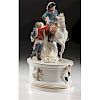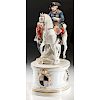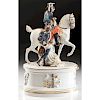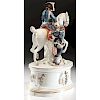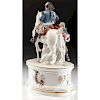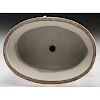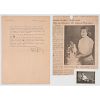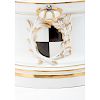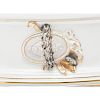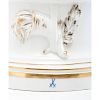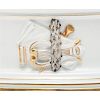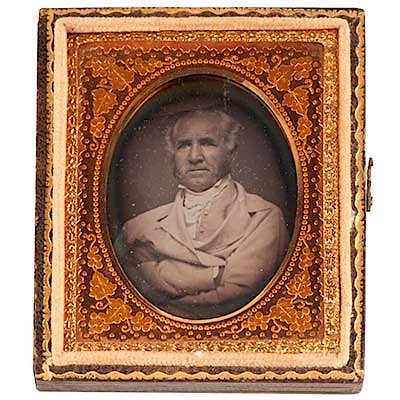Meissen Statue of Frederick the Great, Purportedly Commissioned and Owned by Hitler, with Provenance
About Seller
6270 Este Ave.
Cincinnati , OH 45232
United States
With offices in Cincinnati, Cleveland and Denver, Cowan’s holds over 40 auctions each year, with annual sales exceeding $16M. We reach buyers around the globe, and take pride in our reputation for integrity, customer service and great results. A full-service house, Cowan’s Auctions specializes in Am...Read more
Two ways to bid:
- Leave a max absentee bid and the platform will bid on your behalf up to your maximum bid during the live auction.
- Bid live during the auction and your bids will be submitted real-time to the auctioneer.
Bid Increments
| Price | Bid Increment |
|---|---|
| $0 | $25 |
| $500 | $50 |
| $1,000 | $100 |
| $2,000 | $250 |
| $5,000 | $500 |
| $10,000 | $1,000 |
| $20,000 | $2,500 |
| $50,000 | $5,000 |
| $100,000 | $10,000 |
About Auction
Nov 16, 2018
Cowan’s Fall American History: Premier Auction features over 200 lots including early photographs, documents, manuscripts, broadsides, flags, and more dating from the Revolutionary War period to the mid-20th Century, many representing important landmark moments in American history. Cowan's Auctions dawnie@cowans.com
- Lot Description
German, ca 1940. Meissen porcelain figural group featuring King Frederick II of Prussia astride a white horse, with General Hans von Ziethen to his right, delivering a message, all resting atop an oval plinth decorated with a crowned medallion and crest along with other symbols, overall ht. 18.75 in., lg. 11.5 in. Blue underglaze mark to outer rim of base.
This piece was reportedly created according to orders from Adolf Hitler to the state-owned Meissen Porcelain Manufacturing Plant. This model of King Frederick was originally designed in 1778 by sculptor and Master of Models, Michel Victor Acier, while sculptor Johann Carl Schönheit designed the horse. The original figural group is represented in Fig. 168 of Meissen China: an Illustrated History by Dr. K. Berling, editor.
Included in this lot is a Miami Herald article, ca 1956, featuring a large photograph of a woman identified in caption as "Mrs. C. L. Ownes Jr." admiring the statue. The article is titled "Big and Brawny, He Collects Figurines" and tells the story of Lt. Clarence "Russ" Steber, famous for his 415 missions in the Berlin Airlift, who bought the statue while he was stationed in Germany. The article explains: "Steber befriended a former Luftwaffe flyer who kept on the lookout for interesting art objects which Steber might be interested in buying. As a result Steber's collection was greatly enlarged. He bought Frederick directly from its rescuer."
As for the statue's origin, the article relays Steber's claims that Hitler himself ordered its creation: "Hitler, whose idol was the Prussian conqueror Frederick the Great commissioned Meissen to make two identiacl [sic] figurines of his hero in 1940. One was kept in Eagles Nest, Hitler's mountain hide-out. The other was in his office at the Reichschancellory in Berlin." The article goes on to explain why Steber's statue might be the only one left in existence: "The figurine at Eagles Nest was destroyed by bombing. But when the Allies started blitzing Berlin, one of Hitler's secretaries grabbed this figurine and rushed with it to the bomb shelter - quite a feat as the figures are about a foot high on a heavy base eight inches high."
The article continues, detailing how Steber packed the statue with wet tissues to protect it during its transport to the United States. The concluding line states that the statue will be on display at the Escape Hotel for the remainder of the week.
Also included in the lot are additional documents referencing the history and provenance of the statue. These include an original typewritten letter, dated "12.Dez.1946," written by German museum curator Heiner Ruths who describes the figure, states that it was produced in 1940, and explains that there were two copies created on orders of Adolf Hitler, one of which was probably destroyed; a photocopy of a typewritten and signed receipt from Ronald L. Steber (son of Lieutenant C. R. Steber) confirming the sale of the statue to its current owner; an original silver gelatin photograph, approximately 3.25 x 5.5 in., featuring an unidentified young lady with the statue resting on a piece of furniture in the background; a photocopy of an appraisal by Jan and Lee Walker dated 1989; and photocopies of 1977 correspondence between Lee Walker and George Ware, a expert on German and Austrian Porcelain, concerning the value of the statue featured here.
Adolf Hitler's admiration for Frederick II was widely acknowledged during his lifetime, as he owned and treasured depictions and belongings of the legendary Prussian ruler, some of which were gifted to him by high-ranking Nazi officials. Hitler even ordered the remains of Frederick and his father to be hidden in a salt mine once Allied bombings began in Potsdam, to protect them from being destroyed. It is quite possible, then, that Hitler would have commissioned a statue of one of his most venerated role models to display and enjoy in two of his most important sanctuaries.
Statue has a few small pieces missing including part of Frederick's sword, part of his walking stick, a portion of the horse's reins, two spurs (one of Frederick's and one of General Ziethen's); with repair to bottom of figural group (possibly entirely removed from base at one time).Condition
- Shipping Info
-
Buyers are required to pay for all packing, shipping and insurance charges. Overseas duty charges are the responsibility of the successful Bidder. Be aware that for larger and/or valuable items, shipping charges can be substantial. - If there is no shipping amount on listed your invoice, you will need to make arrangements to pick up or ship your purchase through an alternative shipping company. Our shipping department can be contacted at 513.871.1670 (ext. 219) or email shipping@cowans.com. - Shipping charges include insurance for your order while in transit. If you have private insurance we will adjust your charge to include only packing and shipping. - Please allow 14 – 21 days after payment to package and ship your purchase as carefully as possible.
-
- Buyer's Premium



 EUR
EUR CAD
CAD AUD
AUD GBP
GBP MXN
MXN HKD
HKD CNY
CNY MYR
MYR SEK
SEK SGD
SGD CHF
CHF THB
THB
